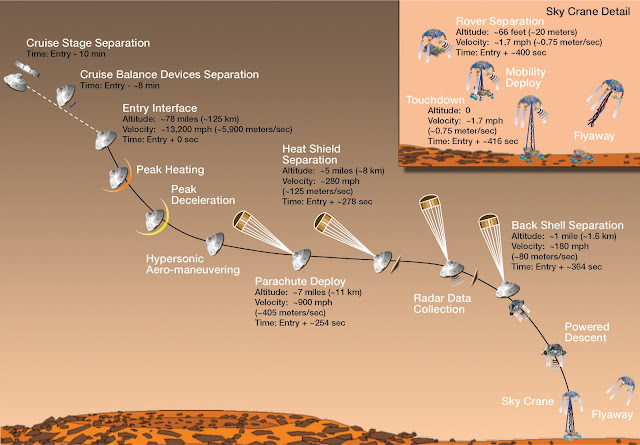On Saturday, November 26 at approximately 10:02AM (EST), Mars Science Laboratory (MSL) lifted off from Cape Canaveral Launch Complex 41 en route to Mars. After more than 8 months in flight, MSL arrives very LATE tonight! The SUV-sized rover it is carrying, called Curiosity, is expected to touchdown on the surface of the Red Planet at 1:31AM (i.e., early Monday morning). After traveling 566 million kilometers, imagine a remote-controlled Cadillac Escalade landing in a dust storm.
This will be no easy feat. In fact, arriving and surviving touchdown would be an enormous scientific and engineering accomplishment. The landing sequence is incredibly risky (see image and 7 Minutes of Terror) and of Mankind's 39 missions to Mars, we've been successful only 15 times. I fully expect very late tonight to be the 16th time we've been successful in landing on Mars but it is important to be aware of the risk of failure and to recognize the extraordinary accomplishment if successful.
Despite the poor odds, we continue to go. Why? Mars Curiosity will open a new opportunity to study the habitable environment of the Red Planet. If you have come to the John C. Wells Planetarium recently, you will have heard me say during my star talk that in my opinion, the greatest discovery in science would be the discovery of life outside of Earth. While NASA's Kepler mission has done an extraordinary job discovering exoplanets, some even in the so-called "habitable zone" where water (should it exist) would be in its liquid form, the best evidence of life outside of Earth may come from within our Solar System, Mars in particular.
Previous missions to Mars has confirmed the hypothesis that Mars had liquid water in its past. But does Mars host life currently? Did it in the past? The answers to these questions have been inconclusive so far. This is where Mars Curiosity comes in. It is landing in Gale Crater, a carefully-chosen landing site after 5 years of analysis. This ~93 mile-wide-crater is an ancient impact basin for which there is very good evidence to suggest an ancient river once flowed through it. It is also a site with mineral-rich terrains and a mountain right in the middle where Curiosity will spend most of its time working to learn if it had an environment where microbes may have thrived.
This story begins tonight! Join me on twitter tonight where I will provide updates and commentary. You can watch NASA TV's feed online if your cable tv carrier does not carry it. Note that once Curiosity lands, it will be 14 minutes for us to receive telemetry that touchdown was successful and another 14 hours to get the first high resolution images that Curiosity will snap from its landing site.
My 2-year old son and I watched the launch on that Saturday morning after Thanksgiving Day and I am going to try to keep him up tonight for this historic landing!
